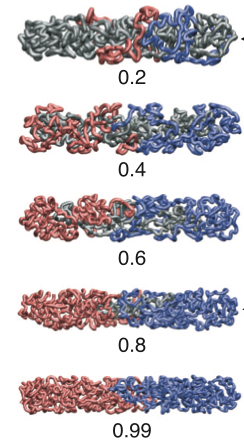Love will tear us apart
 It is found that confining circular chains in a very small enclosure (i.e. looped polymers in a small channel, bacterial chromosomes in a tiny cell, etc.) leads to a spatial separation of the chains into distinct regions of the enclosure. Even if the chains start out well mixed, they will unmix over time.
It is found that confining circular chains in a very small enclosure (i.e. looped polymers in a small channel, bacterial chromosomes in a tiny cell, etc.) leads to a spatial separation of the chains into distinct regions of the enclosure. Even if the chains start out well mixed, they will unmix over time.
What can account for this phenomena?
This section requires Javascript.
You are seeing this because something didn't load right. We suggest you, (a) try
refreshing the page, (b) enabling javascript if it is disabled on your browser and,
finally, (c)
loading the
non-javascript version of this page
. We're sorry about the hassle.
1 cannot be plausible maybe becoz polarizing off loops of chains even if like ends repelled,unlike ends would align and overlapping of loops would take place rather unmixing disorder. 2 maybe again from the same reason as followed from above. If its going to stabilize itself then usually systems of all kind tend to minimize their energy in all possible ways.. 4 I dont have any observed evidence of chains in a rumble.but if friction tends to minimize contact area then grouping of unlike ends would be unclear..
So I think 3 maybe the answer.b coz more the configurations less is the value of energy per loop..so more stable arrangement..
Plz do comment the correct reason and explanation.thanks